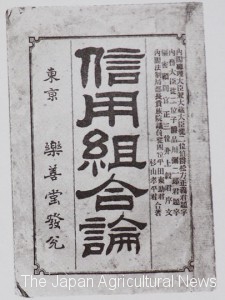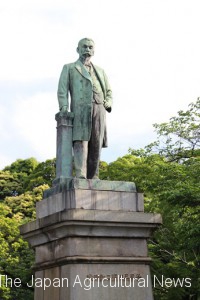The sprouting road to the comprehensive nogyokyodokumiai (agricultural cooperatives)

- ” Shinyokumiai (credit cooperatives) theory” written and published by Tosuke Hirata and Kohei Sugiyama in 1891 (Meiji 24)
Apart from the debate in the Imperial Diet, Ministry of the Interior was challenged to debate on the Shinyokumiai (credit cooperatives) bill by the Ministry of Agriculture and Society of Agricultural Science. Tokiyoshi Yokoi and Masashi Takahashi, Councilors of Society of Agricultural Science, published ” Shinyokumiai (credit cooperatives) theory (and the opinions on Livelihood & economy-cooperatives).”) Yokoi and co-authors claimed, “Legislators must be careful about what to enact the law. Even more it is so, at the case of introducing the foreign country’s system.” “We agree with the spirit of the establishment of Shinyokumiai (credit cooperatives), but the contents of the bill do not meet the spirit. It must not be based on Schulze system of Germany, but it should depend on the principles of the Raiffeisen system “.
The book is said to be the writings by Yokoi and co-authors. But the actual authors are said to be Saku Watanabe, farming manager of the Ministry of Agriculture and Commerce, and Hajime Oda, Counsellor of the Ministry of Agriculture and Commerce (Isao Ito, “Solution”, “The First volume, the great book of Cooperatives”). Watanabe also previously studied cooperatives in Germany, and after returning home, he became a farming manager.
In addition, Tsuneaki Sako ( 1861 ~ 1909 ), Councilor of Society of Agricultural Science, also published the paper in ” Newsletter of Dainihon-Nokai (Agricultural Society of Japan) ” and in the paper he claimed “The law based on Raiffeisen system is suitable for farmers, and the law based on Schulze system is suitable for artisans. “It can be seen that, in Meiji period, Society of Agricultural Science was integral with the Ministry of Agriculture and Commerce and representative of the air of the entire agricultural industry. It was showing signs of controversy between the Ministry of the Interior versus the Ministry of Agriculture and Commerce.
Confrontation of “Toku (virtue)” and “Ri (profit)”
About the characteristic of the Raiffeisen system and the Schulze system, Yokoi and co-authors said as follows;
The principles of the cooperatives based on Raiffeisen system were as follows;
1)one person must not join 2 or more cooperatives, 2) discharging the investment equity system with dividends from profits, 3) long-term loans, 4) unpaid officers except for the accounting officer, 5) loan based on the interpersonal trust by cultivated virtue, 6) Occurred net surplus shall be reserved as cooperatives capital and used for public works only when there is enough.
On the other hand, the principles of the cooperatives based on the Schulze system were as follows;
1)there is no limit of the area of cooperatives, 2) adopting the investment equity system with dividends from profits, 3) short-term loans, 4) paid officers regarding salaries and bonus, 5) the main transactions shall be limited to money transaction including bill issue, discount bill, and credit transaction, 6) profits shall be dividend in accordance with the investment amount of money.
In a nutshell, Raiffeisen system was based on “Toku (virtue)”, Schulze system was based on “Ri (profit)”. There was a big difference.
◇
Of course, Yajirō Shinagawa and Tosuke Hirata also knew existence of cooperatives based on Raiffeisen system and The Rochdale Society of Equitable Pioneers of the United Kingdom. “Shinyokumiai (credit cooperatives) theory” written by Hirata and co-authors mentioned the advantages and disadvantages of each system. Nevertheless, why they adopted the Schulze system as a model?
Because Schulze system was dominated in Germany when Shinagawa and Hirata studied there, and Professor Rochelle (Leipzig University), the teacher of Hirata at that time, highly evaluated Schulze as a social reformer.
Feeling benefit to its investment equity system and the profit dividend principle, wealthy people joined Schulze-based credit cooperatives, so that Schulze-based credit cooperatives grew up but had the tendency to leave from the purpose of aiding the small producer (Teiji Kenjo, “Modern Hotoku thought and Japanese society”).
However, the original intention of Hirata and Shinagawa did not change. In spring of 1896 (Meiji 29), they published ” Shinyokumiai-teiyo (Essence of credit cooperatives) “. In this book, Shinagawa and Hirata also described about raw materials fertilizer purchases cooperatives, joint marketing cooperatives, and machinery utilization cooperatives. Such contents were later reflected in “Sangyokumiai (cooperatives) bill.” There was sprouting of the comprehensive nogyokyodokumiai (agricultural cooperatives) in the book.


